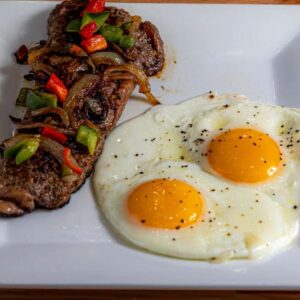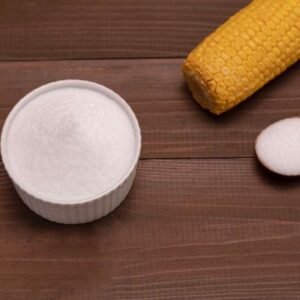
Fight Cancer With This Weird Farmers Market Find (Pictures Inside)
- Taking a bite out of cancer has never been more delicious. Find out more about this family of cancer-busting veggies…
- Move over bananas! Discover a new potassium-rich produce today…
- Plus, one simple way to get more of this cancer-fighting veg in your diet without a lot of hassle!
Dear Living Well Daily Reader,
“Ahhh! What the hell is that?! It looks like an alien’s head or something… There’s no way I am eating that!”
I heard this reaction from a man who had just seen a strange-looking vegetable in his CSA share.
I was a bit surprised to hear such an animated yet genuine response from a grown man about a vegetable.
However, it did intrigue me to find out which veggie shocked him so greatly. Yet I never thought I would have a similar reaction to it. Since I considered myself a farmers market pro, I figured I had seen it all.
But I was wrong…
When I opened the bag and looked at my bounty of farm-fresh produce all I could think was, Whoa, that IS weird!
I quickly asked one of the farmers, Alex, “What on Earth is that?”
He laughed and said, “If you haven’t been in the south very long, then you probably haven’t run across these… but man, are you in luck now… these things are delicious and good for you! I’ll share an easy way to enjoy it with you…”
He was right. This bizarre plant is packed with flavor as well as powerful nutrition.
And it tastes particularly good when prepared as Alex suggested.
We will share this technique with you in a bit; first, let’s talk about this otherworldly-looking veg and why it’s so good for you…
![]() Weird Veggies, Good Health
Weird Veggies, Good Health
Meet kohlrabi…
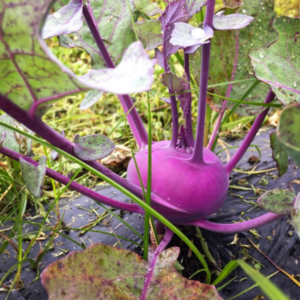
A purple kohlrabi grown by my former CSA.
Source:Rootsmemphis.org
Kohlrabi is a bulb-like member of the Brassica family that also includes cruciferous vegetables like kale, Brussels sprouts, cauliflower, broccoli, and other nutrient-dense cabbages. In German, the name kohlrabi means “cabbage turnip” and is sometimes called a German turnip. Kohlrabi can be green or purple in color, but the flesh of both varieties is white.
From the leaves to its bulbous stem, this entire vegetable is edible, though it’s best if the peel is removed. The leaves can be cooked like other greens or added to a salad.
The stem has a milder and sweeter taste than broccoli but with a slight peppery kick. Its texture is somewhere between an apple and a radish. Peeling your kohlrabi until you can see the white flesh is essential before cooking or eating it. The peeling is very fibrous and may get stuck in your throat (trust me, I learned this lesson the hard way).
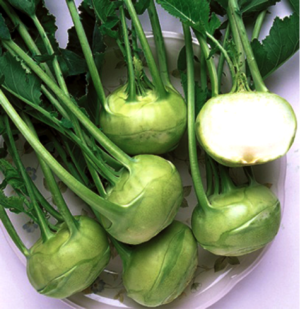
Green kohlrabi.
Source: nicholsgardennursery.com
But kohlrabi is more than just a tasty addition to your meals — it has some serious health-boosting powers too.
Cruciferous vegetables like kohlrabi are loaded with cancer-fighting components. In fact, some studies show that by just eating cruciferous veggies, you may lower your risk of cancer and can even halt the growth of cancer cells including tumors in the lungs, colon, liver, cervix, and breasts.1,2
And the good news doesn’t stop there…
Kohlrabi is loaded with vitamin C. A one-cup serving contains 138% of your daily needs. Plus, the same serving contains more potassium than a medium-sized banana! 3This means kohlrabi is a good choice for heart and immune support! And kohlrabi is great source of fiber, which can help with digestion and blood sugar levels.
As you can see, kohlrabi has a lot of health benefits to offer you!
So without any further ado, we will share Alex’s simple, yet delicious kohlrabi cooking secret…
![]() Simply Delicious
Simply Delicious
Before you can eat kohlrabi, you have to find some. As Alex pointed out, you may have more luck at farmers markets if you are living in the Southern states, but that doesn’t mean you shouldn’t try looking there if you live in a different region. Other good places to look are specialty food stores and Asian markets.
There is no difference in taste or nutritional value between the green kohlrabi and purple kohlrabi, so don’t worry if you can only find one or the other. However, the one thing that does affect the taste is bulb size. Smaller bulbs have a sweeter and milder taste, so it’s best to purchase those.
Once you get your hands on some, start peeling and chopping! Fresh kohlrabi is a great addition to soup, salads, and slaws. You can keep peeled and chopped kohlrabi in your fridge for up to five days, making it the perfect garnish or last-minute addition to any meal.
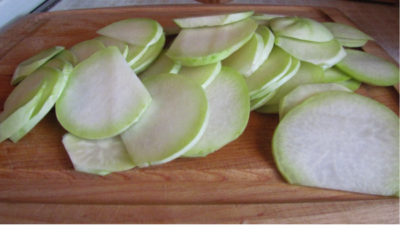
Some sliced kohlrabi ready for snacking!
Source: beyondpaisly.net
But if you want to enjoy kohlrabi in its purest form, use Alex’s method — peel, slice thinly, and sprinkle with a bit of sea salt. It makes a great afternoon snack or the perfect addition to a picnic basket.
Live well,

Natalie Moore
Managing editor, Living Well Daily
P.S. Do you have any produce you don’t know what to do with? Let me know! nmoore@lfb.org
Sources
[1] FOODS THAT FIGHT CANCER: Broccoli & Cruciferous Vegetables
[2] Epidemiological studies on brassica vegetables and cancer risk
[3] Basic Report: 09040, Bananas, raw
Written By Natalie Moore
Natalie Moore is a dedicated health researcher with a passion for finding healthy, natural, and science-based solutions. After a decade of direct healthcare experience in western and natural medicine, she was involved in public health research before joining Living Well Daily.
View More Free Articles
This Sleep Mistake Is Doubling Your Disease Risk
Think your inconsistent bedtime is just a harmless habit? Think again. New research reveals that going to bed at different times each night isn’t just making you tired—it could be dramatically increasing your risk of serious diseases. But the key to making sure poor sleep doesn’t derail your health goals likely isn’t what you think…....
Stop Obsessing Over Diet Trends
Can we stop with the endless diet debates already? Every other week there’s a new headline shouting about which diet is best for weight loss, heart health, or diabetes. Paleo, keto, low-carb, high-protein… it’s exhausting. And now, a new meta-analysis is out comparing the Mediterranean diet, the DASH diet, and something called AHEI (that’s “Alternative...
A New Reason to Ditch Processed Junk
If you’ve ever walked the inside aisles of your local grocery store and thought, “This is all just junk,” your instincts were spot on. A new study published in the journal Thorax just added another red flag to the list of dangers linked to ultra-processed food—a 41 percent higher risk of lung cancer. That’s right....
When Being Winded on Stairs Is Serious (And When It Isn’t)
I had an athlete visit me recently because he experienced shortness of breath while climbing stairs. He is in great shape, so he was worried about what it might mean. “Doc,” he said, “I run five miles three times a week. Why am I huffing and puffing after two flights of stairs?” His concern is...
Study EXPOSES Hidden Danger Lurking in Your Car
We think of our homes and cars as safe havens. But according to a startling new study, they may be flooding your lungs with microscopic plastic particles—every single day. Researchers in France recently found that adults inhale an average of 68,000 microplastic particles daily from indoor air alone. To put that in perspective, that’s about...
Mailbag: Is Modern Food Making You Snore?
“What can cause snoring, and is there a way to correct this issue?” —Seeking Silence Hi Seeking, Snoring happens when the soft tissues in your throat relax and vibrate as air passes through during sleep. While several factors can cause snoring—from sleep position to nasal congestion—I want to share one trigger that might surprise you....
Simple Food Swap SLASHES Dementia Risk 28%
Let’s be honest… who would jump at the chance to cut their dementia risk by 28 percent. And no, you don’t need to run marathons, survive on broccoli, or learn to play the zither (whatever that is) to make it happen. All it takes is one easy swap—something that’s probably already in your refrigerator. Researchers...
This SMART Floss Exposes Hidden Health Danger
Scientists have created dental floss that doesn’t just clean between your teeth—it also tracks your stress while you’re flossing. Now, I know what you’re thinking… “Great—now even flossing is going to stress me out by telling me how stressed I am.” But this fascinating new tool from Tufts University could be a game-changer for understanding...
Is This "Safe" Sweetener Damaging Your Brain?
The headlines are alarming… “Popular Sugar Substitute Linked to Brain Cell Damage” and “Erythritol Could Damage Critical Brain Barrier” are just two of the dozens I’ve spotted recently. But before you toss every sugar-free product in your pantry, let’s take a closer look at what this study actually shows—and what it doesn’t. The latest research...
This Summer Threat Could SPIKE Your Blood Sugar
Picture this… It’s another scorching hot summer day. You crank up the air conditioning while watching the weather forecast, which predicts yet another “record-breaking” heat wave. It’s starting to feel like just another miserably uncomfortable summer. But what you might not realize is that—if you have diabetes—those rising temps could do far more damage to...






